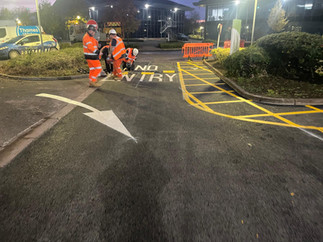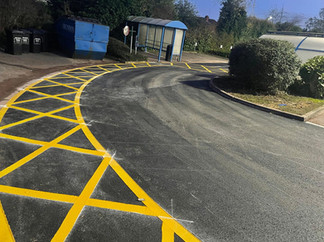Challenges and Successes: Tarmac Resurfacing Project at Thames Water Reading Test Labs
- John Cook
- Nov 12, 2024
- 2 min read
Tarmac resurfacing projects can be quite a challenge, especially when they are time-sensitive and come with the unpredictability of British weather. A recent project at Thames Water’s Reading Test Labs illustrates this perfectly. With tight deadlines and high expectations for safety and efficiency, the team faced significant hurdles but ultimately found success. This post will unpack the project's key components, the obstacles encountered, and the achievements celebrated.
Project Overview
KCC took the lead on this important project, ensuring that the entire operation ran smoothly, while Toppesfield handled the tarmac surfacing itself. The aim was clear: to enhance the road conditions for safe and efficient access to the facility, aligning with Thames Water's high standards.
In the initial phase, the team skillfully planed off a substantial 50mm of the existing surface. This process ensured a solid foundation for a new, tougher layer of tarmac. To prepare for a long-lasting surface, any holes were filled with AC20, creating an even base.
Regulating and Replacing the Surface
Once the old surface was planed, the focus shifted to laying down a new surface using AC10, a reliable bitumen mix known for its durability. Given that this area experiences significant traffic, utilizing AC10 was essential for improving the surface quality and ensuring the safety of all users.
The entire resurfacing was planned for a single weekend. This tight timeframe was crucial to minimize disruptions to Thames Water operations. Completing such an extensive task in just two days was no easy feat, but it was necessary for maintaining efficiency while achieving high-quality results.
Challenges Faced
Among the main challenges was the unpredictable autumn weather. The team faced a range of conditions, from light drizzle to unexpected downpours, which complicated the application. Making sure the materials adhered correctly while maintaining high quality required constant vigilance and flexible planning.
Additionally, coordinating the efforts of both KCC and Toppesfield was critical. It was essential that all team members understood their responsibilities and the project timeline, especially since any delays could affect both the completion and the performance of the new surface.
Adding Safety Features
After finishing the tarmac resurfacing, the team applied new white line markings and hazard indicators to the road. These features are vital for directing pedestrian traffic and ensuring safety at crossings.
The enhanced road and footpath markings dramatically increase visibility, which is known to reduce accident rates by as much as 30%. By clearly defining pedestrian walkways and crossing points, the project has significantly improved safety around the Test Labs.
Final Thoughts
Reflecting on the tarmac resurfacing at Thames Water’s Reading Test Labs, it is evident that both the challenges and successes were instrumental in improving the space. The project not only enhanced immediate safety and access but also set a standard for future initiatives.
Despite facing tough conditions like unpredictable weather and a tight schedule, the collaboration between KCC and Toppesfield was crucial. This project highlights the importance of thorough planning, flexibility, and teamwork in infrastructure projects.
The outcome serves as an influential guide for future resurfacing projects in similar environments. By focusing on continuous improvement and dedication to quality, safety and accessibility will always remain priorities in tarmac resurfacing initiatives.
.png)
























































Comments